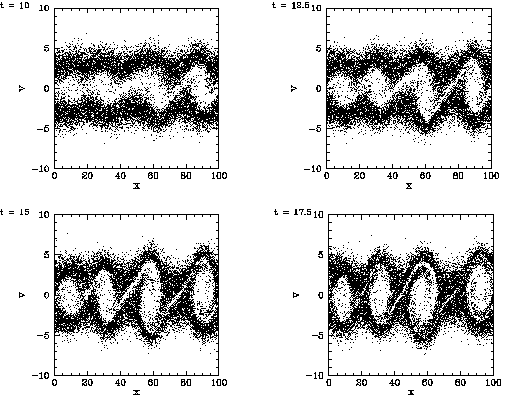


Next: Discussion
Up: Particle-in-cell codes
Previous: An example 1D PIC
Figures 89 and 90 show the electron phase-space distributions
evaluated at equally spaced times for a two-stream instability calculation
performed with  electrons. It can be seen that the distribution
initially takes the form of two uniform bands, corresponding to two
counter-streaming electron beams. However, as time progresses, the
bands spontaneously develop structure which grows in magnitude and
eventually converts the phase-space distribution into a set of connected
vortices. In this final state, the electrons are basically bouncing backwards
and forwards in a quasi-periodic electric potential generated by non-uniformities
in the electron density. In other words, the instability effectively destroys the two
beams. For this reason, the two-stream instability is of major
concern in particle accelerators, which often consist of counter-propagating
charged particle beams.
electrons. It can be seen that the distribution
initially takes the form of two uniform bands, corresponding to two
counter-streaming electron beams. However, as time progresses, the
bands spontaneously develop structure which grows in magnitude and
eventually converts the phase-space distribution into a set of connected
vortices. In this final state, the electrons are basically bouncing backwards
and forwards in a quasi-periodic electric potential generated by non-uniformities
in the electron density. In other words, the instability effectively destroys the two
beams. For this reason, the two-stream instability is of major
concern in particle accelerators, which often consist of counter-propagating
charged particle beams.
Figure 90:
The electron phase-space distribution evaluated
at various times for a 1-dimensional two-stream instability calculation performed with  ,
,  ,
,  ,
,  , and
, and  .
.
 |
Richard Fitzpatrick
2006-03-29

